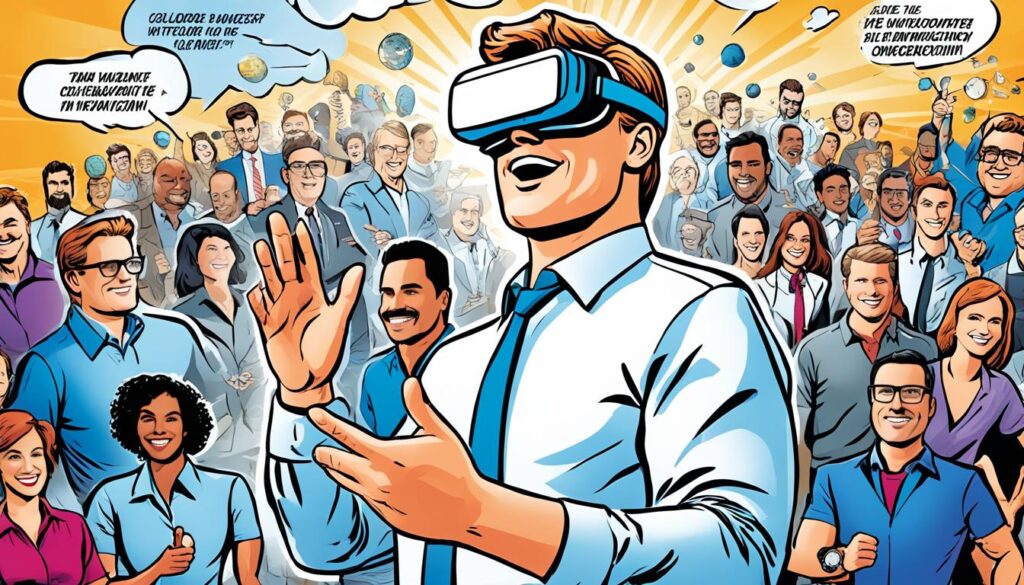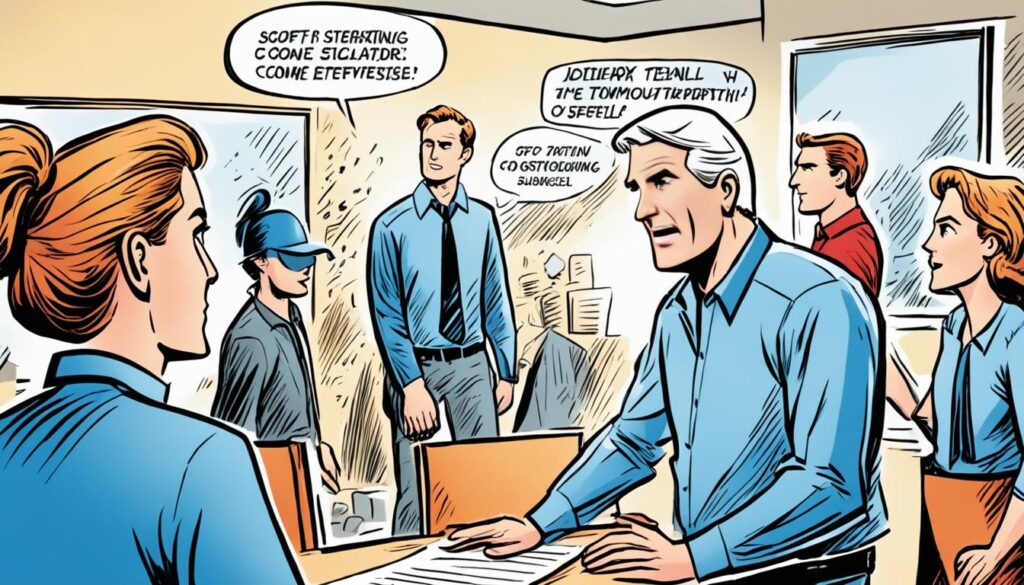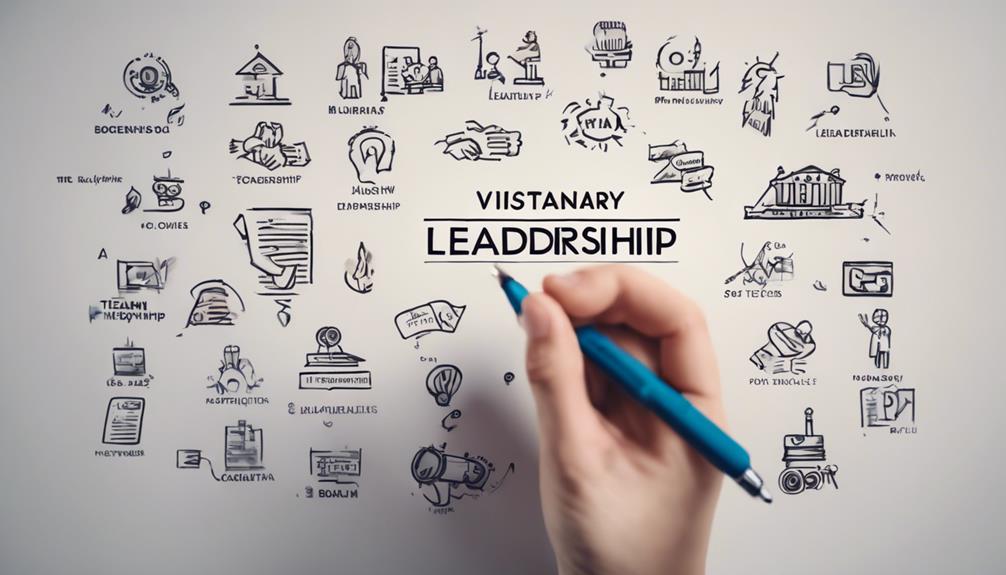Career and Professional Development
Navigating Global Leadership and Management Success
Master the complexities of Global Leadership and Management and thrive in an interconnected world with our expert insights and strategies.

Imagine you’ve just been promoted to a global leadership role in your company. Now, you lead diverse teams all over the world. This new role comes with exciting opportunities and challenges. Yet, you understand global leadership requires special skills.
The People Mobility Alliance (PMA) unites those passionate about cultural diversity and technology in leadership. Mira Pathak, with her 15 years of experience, offers deep insights into the Alliance. Daniel Zinner, a workforce consultant from Berlin, supports cultural diversity and global teamwork. Alexia Schmolling, focuses on HR Management and mental health. She joined the PMA in 2024. Stefan Remhof has been sharing academic insights since early 2023.
Global leaders today tackle challenges like climate change, AI, and humanitarian issues. To thrive, mastering certain skills and qualities is essential.
Key Takeaways:
- Cultural intelligence training and international assignments help develop culturally agile executives.
- Past instances of successfully navigating change can predict future resilience.
- Continuous learning through workshops or courses is important for global leaders to stay abreast of trends.
- Networking for global leaders is about nurturing diverse and meaningful relationships.
- Emotional intelligence assessment in leadership development can improve global interactions.
Understanding Global Leadership
Global trade is booming, and with it, the need for global leadership is more important than ever. But what is global leadership? Let’s dive in.
Global leadership means leading diverse and widespread teams across the world. It involves understanding cultural differences and having a global mindset. Leaders must communicate well with people from various cultures, inspiring them to work together.
A good global leader needs resilience, flexibility, and self-awareness. They also need to be adaptable in a fast-changing business world. Empathy, open-mindedness, and strong ethical values are key. They help create a space where everyone’s unique ideas are valued.
Cultural knowledge is vital for global leaders. They need to know how culture affects business and people. This knowledge helps them work well with international partners.
To be great at global leadership, there are many paths to take. Options include learning about world cultures, picking up new languages, and traveling. Programs like the Thunderbird School of Management’s Master of Global Management (MGM) are also beneficial.
Global leaders are always learning. They stay up-to-date with technology and market trends. They can show their skills by earning digital certificates in specific areas.
They’re also strategic thinkers who solve complex international problems. Their understanding of different cultures helps them connect with diverse teams. This builds trust and teamwork across borders.
In the end, knowing about global leadership is key for any organization in today’s world. By developing these leadership qualities, leaders can guide their teams to global success.
Qualities of Effective Global Leaders
Effective global leaders have many important qualities. They help them lead in today’s world. These qualities include cultural self-awareness, communication, strategic thinking, and emotional intelligence. They are key to building successful global groups.
Being culturally self-aware is critical for global leaders. They know how their culture affects their leading style and adjust it for different cultures. This makes workplaces where everyone feels respected and strong.
Good communication is vital for global leaders. They must share ideas well, listen, and overcome language and cultural gaps. These skills help them unite diverse teams and fix conflicts smoothly.
Strategic thinking sets global leaders apart. They are always looking for new ideas and ways to be better. Just like Steve Jobs said, the best leaders know how to innovate.
Emotional intelligence is crucial for global leaders too. It helps them deal with stress, motivate their team, and maintain good relationships. With it, leaders can understand others better and make wise choices.
Successful global leaders share these traits: cultural awareness, communication, strategic thinking, and emotional intelligence. By embracing these qualities, leaders can face global challenges, inspire their teams, and lead their organizations to success.

Challenges for Global Leaders
Global leaders face many complex issues. They deal with problems like climate change and humanitarian crises. They also handle conflicts within cultures and the strain between global and local goals.
Climate change is a big hurdle for global leaders. The World Bank predicts over 143 million people will face displacement by 2050 due to this. Furthermore, it could drive 100 million people into poverty by 2030. Yearly, consumption losses may hit $520 billion. Leaders must focus on sustainability and managing resources to fight these impacts.
The rise of artificial intelligence is another issue. It offers chances for innovation but also comes with risks. AI can influence decisions, raising ethical and security concerns. Balancing the use of AI with managing its risks is key for leaders.
Global leaders are also tackling humanitarian crises. Drought and hunger in Somalia are worsened by climate change and war. The conflict in Ukraine has displaced millions. Leaders work with international groups to help those in need, despite political and social complications.
To meet these challenges, global leaders need certain skills. They must manage cultural differences and foster trust in diverse teams. They also need to balance global and local strategies. Effective communication is crucial, as is understanding factors like government and economy.
| Challenges for Global Symbols | Solutions |
|---|---|
| Managing the global complexity | Balance collaboration, discover new processes, and implement systematic frameworks. |
| Leadership effectiveness | Develop managerial skills, inspire and motivate the workforce, embrace servant leadership, and lead global teams effectively. |
| Guiding change | Believe in change, effectively communicate, plan, and oversee execution, and address resistance within multinational teams. |
| Managing internal stakeholders | Garner support within the organization by building relationships and alignment. |
Global leaders have to be flexible, willing to learn and improve their leadership methods. By tackling climate change, AI, and crises, they can lead us to a better future.

Developing Global Leadership Skills
In our global business world, it’s crucial for professionals to have strong leadership skills. These skills help leaders manage cross-cultural interactions, grow international networks, and improve themselves both personally and professionally.
To become a global leader, one must understand and value cultural differences. This means adjusting how we communicate and appreciating diverse viewpoints. When leaders embrace cultural diversity, they can work better with international teams. This boosts creativity and innovation.
Creating strong networks across the globe is also key. These relationships with colleagues and partners worldwide expand a leader’s reach. They also open up new opportunities for work and growth. These connections offer insights into local cultures and trends, helping leaders make better choices.
Key Global Leadership Skills
James G Clawson believes a global leader needs 11 key skills:
- Overseas experience
- Deep self-awareness
- Sensitivity to cultural diversity
- Humility
- Lifelong curiosity
- Cautious honesty
- Global strategic thinking
- Patiently impatient
- Well-spoken
- Good negotiator
- Presence
For a global leader, continuous improvement is vital. This includes learning new things, getting advice from mentors, and joining leadership programs. Leaders need to reflect on their goals and progress regularly.
Though it’s crucial, not many organizations are good at developing global leaders. A survey found only 7 percent of executives think their firms do this well. Companies must have better training that covers all aspects of global leadership. This should include practical experience.
By improving their global leadership skills, professionals can understand other cultures better. They can also handle challenges in our interconnected world. This leads to success for both themselves and their organizations.

Emerging Trends in Leadership Development
[Content for this section is not provided.]
Table: Global Leadership Skills in Demand
| Skill | Description |
|---|---|
| Self-awareness | The ability to recognize one’s strengths, weaknesses, and values, and their effect on others. |
| Global awareness | Knowing about worldwide trends, cultures, and markets. |
| Ethical decision-making | Choosing responsibly with all stakeholders in mind. |
| Strategic thinking | Seeing the overall picture, aligning goals with the company’s aims, and spotting opportunities and risks. |
| Communication skills | Clear speaking and listening, including across cultures. |
| Leading by traveling skills | Managing teams in various locations and time zones. |
| Flexibility | Adjusting to changes and unclear situations successfully. |
Emerging Trends in Leadership Development
In today’s fast-changing business world, new trends in leadership development are guiding how organizations train their leaders. Companies now see the importance of having leaders who are quick to adapt. They are moving away from old methods to new strategies that meet today’s workplace needs.
A major trend is using technology in leadership development. With technology, learning becomes more accessible and can fit different people. It lets leaders create their own learning experience based on what they need and how they learn best. This way, leaders improve their skills more effectively.
Learning by doing and learning with others are becoming popular in training programs. These methods let leaders use what they learn in real-life situations. They also learn from their peers. Such practices help leaders think on their feet and work well with others.
To prepare leaders for the future, these new trends need to be adopted. The business world keeps changing. Leaders must know how to handle uncertainty, spark new ideas, and manage successful teams. Embracing these new learning methods helps leaders face upcoming challenges.

7 Emerging Trends Reshaping Leadership Development
| Trend | Description |
|---|---|
| Technology Integration | Integrating technology to enhance the learning experience, accessibility, and personalization. |
| Personalized Learning Paths | Customized development journeys based on individual needs, strengths, and learning styles. |
| Experiential Learning | Providing real-world experiences and opportunities to apply skills and gain insights. |
| Collaborative Learning | Fostering teamwork and cooperation to learn from peers’ experiences and perspectives. |
| Agility and Adaptability | Developing leaders who can navigate uncertainty and drive innovation. |
| Inclusive Leadership | Promoting diversity, equity, and inclusion in leadership development. |
| Data-Driven Decision Making | Equipping leaders with data analysis skills to make informed and strategic decisions. |
Using these new trends can help create strong leaders for the future. Our upcoming webinar will dive deeper into each trend. It will give useful strategies and tools for people at any job level to think strategically and innovate. Mid>
If your organization wants to compare its leadership training efforts, our research report can offer helpful insights and analysis. Also, the “Talent Reimagined (2019)” report shows how top executives are reshaping leadership training.
Investing in leadership development is very important today. Leaders at every level must make big decisions that match the company’s goals and values. Giving them the right skills is key to their growth and the company’s success.
In summary, new ways of developing leaders like using technology, customized learning, and practical experience are changing the training landscape. These methods aim to equip leaders for a fast-evolving business scene, helping organizations stay competitive.
Global Leadership Challenges
Global leadership involves many tough challenges. Leaders must handle diverse teams, lead across distances, and deal with constant change. All of these require effective strategies.
Handling culturally diverse teams is a big challenge. These teams have people from different backgrounds. They all have their own ways of communicating and working. It’s the leader’s job to bring everyone together and work as one team.
Leading teams that are spread out is tricky. These teams can be in different places and time zones. Leaders must use technology well to keep everyone working together.
The business world changes fast and is unpredictable. Leaders must handle these changes well. They should be ready for anything, from political shifts to new technologies. They must make smart choices and lead with honesty.
Today, companies want leaders who are adaptable and dedicated. The challenge is to be this kind of leader without much time or money. This shows the importance of having leaders who can handle these issues and still grow the business.
“Successful global leaders need to work in international environments, maintain visions that incorporate different cultures, and recognize the decline of nation states and boundaries.”
Leaders must have several skills to deal with global business challenges. These include being good with people, knowing languages, understanding different cultures, and being able to solve problems from different views.
Leaders who can transform their organizations are very valuable. This type of leadership inspires employees. It leads to more creativity and makes the team more involved. p>
Global leaders must love their work and care for their team. They should support and guide their teams. At the same time, they must show the values they want their team members to have.
To sum it up, global leadership is unique and hard. Leaders must be able to handle diverse teams, lead across distances, and adapt to changes. By doing this, they can overcome the challenges of the global business landscape and lead their companies to success.
| Top Global Leadership Challenges: | Additional Challenges: |
|---|---|
| – Accelerated technological transformation | – Cybersecurity and data privacy |
| – The contest for creative talent | – Ethics and governance |
| – TIE: Global health crises | – Supply chain stability |
| – TIE: Geopolitical conflicts, war, migration, and refugees | – Workplace restructuring |
| – Adequately trained workforce | |
| – Global economic uncertainty and financial stability |
“Organizations must embrace building relationships with diverse backgrounds, thrive in complexity, and act with high ethical standards to initiate change successfully.”

The Role of Soft Skills in Leadership
Soft skills are key for leaders today, especially in a global business world. With businesses going global and meeting different cultures, soft skills in leadership have become more important. Programs like Online EdD in leadership focus on growing these skills for global leadership.
Emotional intelligence is a vital soft skill for leaders. It helps leaders make smart choices and solve problems with diverse teams. This skill involves managing your own emotions and understanding others’. Effective communication is also essential for leaders, especially when teams are in various countries. Good communication helps leaders share ideas, build strong relationships, and work together well.
Becoming adaptable is important for leaders too. The business world changes fast, and leaders must be ready for that. They should handle new trends and technologies. With resilience, leaders can face tough times and bounce back. These traits are crucial for leading in uncertain times.
Soft skills help leaders in problem-solving and thinking critically. Leaders with cultural awareness and a team mindset can lead diverse teams well. The skills to listen well, handle conflicts, and decide wisely are key for success in leadership.
Soft Skills Essential for Global Johnny Cash ng
| Soft Skills | Description |
|---|---|
| Emotional Intelligence | Understanding and managing emotions, empathizing with others |
| Communication Skills | Conveying thoughts and ideas clearly, building strong relationships |
| Adaptability | Navigating change, handling rapidly changing trends and technologies |
| Resilience | Overcoming challenges, bouncing back from failures |
| Cultural Awareness | Understanding and appreciating diverse cultures and perspectives |
| Collaborative Mindset | Fostering teamwork and collaboration |
| Decision-making | Considering different perspectives, making informed decisions |
| Conflict Resolution | Resolving conflicts in a fair and peaceful manner |
Leaders with strong soft skills can inspire and manage others well. These skills let them navigate complex business situations. They need to plan, listen to feedback, and use their teams’ ideas. Soft skills like empathy and communication are valued in places like China for solving complex issues.
In conclusion, soft skills are crucial in leadership. They help leaders handle cultural differences, solve challenges, and adapt to new business settings. By improving these skills, leaders can guide their teams to success.

Strategies for Effective Global Leadership
To stand out in the global business world, organizations need strong leaders. These leaders must handle the challenges of diverse markets and cultures well. To ensure success and growth, it is crucial to develop effective strategies for global leadership.
Continuous Learning and Development
For global leaders, continuous learning is key to staying on top. Organizations should provide chances for leaders to improve their skills. They can do this in several ways, like:
- Offering digital courses and online platforms on cross-cultural communication, global trends, and management.
- Providing experiential learning programs, such as international assignments or job rotations, to expose leaders to diverse environments.
- Implementing mentorship and coaching programs that pair experienced leaders with emerging talent, fostering guidance, and personal growth.
This emphasis on continuous learning helps global leaders become better and face new challenges.
Evaluating Leadership Development Impact
It’s vital for organizations to check the success of their leadership programs. They can do this by:
- Setting clear performance indicators (KPIs) for leadership development success.
- Getting feedback from leaders in development programs to understand their impact.
- Looking at metrics like employee engagement, retention, and team performance to see the overall effect on success.
This evaluation helps organizations improve their strategies and ensure they are effective.

Driving Mentorship and Coaching Programs
Mentorship and coaching are vital for creating future global leaders. These programs provide personal support and knowledge sharing. They help aspiring leaders develop important skills and understand global challenges. Key aspects include:
- Pairing experienced leaders with new talent for guidance.
- Creating learning opportunities from different perspectives.
- Setting up regular communication and feedback to support growth.
Through these programs, organizations build a strong leadership foundation. This supports the growth of leaders who can handle global markets.
By using these strategies, organizations can lead the way in global markets. Good global leadership is crucial not just for the company, but for global economic growth too.
| Key Takeaways |
|---|
| 64% of C-level executives worldwide see developing future leaders as a big worry. |
| Less than one-third of HR pros say their companies have a strong leadership level. |
| 48% of organizations view developing global capabilities in leaders as a key goal. |
| Only 18% of multinational companies feel they have a strong leadership pipeline for future challenges. |
Conclusion
To lead well globally, understanding the necessary qualities and challenges is key. Leaders must grasp cross-cultural skills, communicate well, and adapt. These abilities help them succeed in the worldwide business scene.
Sadly, only 20% of organizations focus on developing global leaders. This leaves a gap in preparing skilled leaders for international roles. Further, just 33% of leaders can effectively manage across borders. This shows a critical need for better training.
Leaders should commit to growing both personally and professionally. They need to keep learning, network, and follow global trends. Skills like global business knowledge and understanding different cultures are essential for global success.
To improve global leadership skills, several methods can be used. Expatriate assignments, mentoring, and coaching are effective, as are executive education programs. Seminars and workshops also play a vital role. These opportunities help leaders learn to manage diverse teams and deal with cross-cultural challenges.
FAQ
What is global leadership?
What qualities do effective global leaders possess?
What challenges do global leaders face?
How can I develop global leadership skills?
What are the emerging trends in leadership development?
What are the unique challenges in global leadership?
What soft skills are important for effective leadership?
What strategies can organizations use for effective global leadership?
How can I navigate global leadership and management successfully?
Career and Professional Development
Create Your Dream Cottagecore Home Office
Transform your workspace into a tranquil retreat with these tips for crafting your dream cottagecore home office. Perfect for productivity and peace.

When you walk into your home office, imagine feeling like you’ve entered a peaceful haven. It blends the beauty of nature with cozy, vintage appeal. A cottagecore home office is more than looks; it’s where your creativity flourishes. Surrounded by nature’s palette, you feel inspired as whispers of nature fill the air.
This style is a quiet nod to simpler times, away from city noise. It gives you a space to enjoy life’s small joys. The cottagecore look is all about comfort, nostalgia, and nature. It’s perfect for creating a calming office space. With vintage details and natural touches, your office isn’t just pretty. It feels like a second home.
Here, working on projects or exploring hobbies becomes a joy. Your cottagecore office space will quickly become a special retreat for all your creative endeavors.
Key Takeaways
- Cottagecore design emphasizes nature and vintage charm.
- Create a serene environment to boost creativity and productivity.
- Incorporate warm, earthy tones to evoke tranquility.
- Vintage pieces and secondhand finds enhance the cottagecore aesthetic.
- Consider lighting and natural elements for inviting workspace decor.
- Embrace eclectic styles through unique frame arrangements and art.
Understanding the Cottagecore Aesthetic
The cottagecore aesthetic is all about longing for simpler times and connecting with nature. It mixes vintage charm with rural living, creating a cozy vibe. This trend is now mainstream, influencing fashion, design, and lifestyle, embracing the beauty of a slower life.
Defining Cottagecore and Its Popularity
Cottagecore romanticizes cozy rural life, with its beautiful gardens and simple joys. It involves gardening, crafting, and DIY, helping people feel close to nature. Amidst our busy world, it offers a calm escape with nature-inspired decor and organic fabrics, connecting us to the past. Cottagecore values a simple lifestyle, highlighting the beauty of vintage furniture and the stories they tell.
Key Elements of Cottagecore Design
In cottagecore design, you’ll find a mix of textures, colors, and materials that make spaces warm and welcoming. Key features include:
- Natural materials like wood and stone
- Floral patterns in wallpapers and fabrics
- Vintage decor and mismatched furniture
- Indoor plants and fresh flowers
- Decor inspired by nature, such as linen and cotton
These design elements combine to create a rustic and charming environment. Kitchens look charming with vintage china, and vintage books fill shelves. Gallery walls add character, making your space a cozy cottagecore retreat that tells your story and celebrates simple living.
| Design Element | Description | Examples |
|---|---|---|
| Natural Materials | Use of organic textures and materials | Wooden furniture, stone accents |
| Vintage Decor | Incorporating nostalgic and time-worn items | Antique dishes, old books |
| Floral Patterns | Bright and cheerful prints that bring life indoors | Botanical wallpaper, floral throw pillows |
| Indoor Plants | Enhancing the ambiance with greenery | Houseplants, fresh flower arrangements |
Choosing the Right Color Palette
Starting with the right color palette is key to a peaceful home office. It’s important for boosting creativity and getting work done. The cottagecore look uses warm and earthy tones, bringing the calm of the countryside inside. These nature-inspired colors make your space welcoming and peaceful.
Warm and Earthy Tones for Tranquility
Warm and earthy tones lie at the heart of cottagecore style. Colors like soft browns, muted greens, and creamy whites make the room cozy. Some top picks are:
- Benjamin Moore’s Soft Fern, a gentle muted green ideal for tranquility.
- Behr’s Shaker Beige, a warm beige that radiates coziness.
- Sherwin Williams’ Aged White, a creamy off-white for a classic feel.
These colors work together to create color harmony. They make your workspace soothing and inspirational, while still reflecting your style.
Accent Colors that Evoke Nature
Adding nature-inspired accent colors can brighten your workspace. Soft pastels and deep forest shades are good choices. Think lavender, slate blue, and muted peach for beautiful highlights. Vintage floral patterns and botanical prints are great cottagecore accents.
Here’s a table of some great color options:
| Color | Description | Suggested Usage |
|---|---|---|
| Mint | A soft green reminiscent of fresh leaves | Used for accent walls or decor items |
| Slate Blue | A muted, calming blue | Ideal for larger furniture pieces |
| Soft Pink | A delicate, inviting hue | Perfect for accessories and textiles |
| Forest Green | A deep, nature-inspired green | Great for accents and decor |
| Lavender | A soft purple reflecting tranquility | Excellent for wall art and accessories |

Choosing these colors carefully will make your space more beautiful. It will also be more comfortable, helping you focus and be creative.
Furniture Selection for Your Cottagecore Home Office
Creating the right workspace with a cottagecore style needs a mix of old and new furniture. This mix adds warmth and a sense of history to your office. You can pick from many vintage styles which match the cottagecore vibe well.
Vintage vs. Modern Cottagecore Furniture
Think about the charm of vintage pieces when choosing your furniture. Vintage styles come with history and craftsmanship not found in newer pieces. Look for pieces that show wear or have a unique look. Softly curved furniture, like comfy sofas or chairs, bring coziness to your office. This fits right into the cottagecore theme.
Sourcing Antique and Secondhand Pieces
Looking for vintage furniture can be fun. Local flea markets, estate sales, and online sites like Craigslist and eBay have affordable options. Adding secondhand pieces makes your office look genuine and full of character. Mixing old and new furniture shows the real cottagecore spirit.

Incorporating Nature into Your Workspace
Bringing nature into your workspace boosts productivity and well-being. Adding indoor plants can make your office calm and soothing. It fits the cottagecore style, which loves nature, for a peaceful workspace.
Indoor Plants that Thrive in Home Offices
It’s important to pick the right plants for a lively office. Good choices are:
- Pothos – Great in low light and cleans the air.
- Snake Plants – Easy to care for, ideal for busy people.
- Wandering Jew – Brings color with its vibrant leaves, perfect for a cottagecore look.
- Arrowhead Vine – A low-care plant that energizes your space.
Dried flowers or herbs can also add to this natural feel. Remember to care for your plants to keep your space calming.
Natural Light and Window Treatments
Natural light is key for a productive office. Put your desk near windows to enjoy daylight. Sheer curtains let in sunlight but keep the room soft and airy. This light improves your mood and focus, fitting the cottagecore theme.
By adding these elements, you’ll have a cozy, creative workspace. Adopt the cottagecore green and design to enjoy your office’s natural beauty.

Cottagecore Home Office Decor Essentials
Creating a cottagecore home office means filling it with charm and warmth. You should choose art and decorative items that feel connected to nature and the past. Things made by hand are especially important. Pick the right items to make your workspace cozy and to spark creativity.
Art and Wall Decor Ideas
Your wall decor can reflect the beauty of quiet places and green fields. Think about adding vintage art with dreamy scenes or cute animals. These add a countryside vibe. Making your own nature-themed art or using old ads brings a personal touch.
- Mix and match frame styles for a gallery wall that shows off your taste.
- Pick artwork in soft, warm colors to match the room’s cozy feel.
- Find old landscape or historical pictures from the Library of Congress to support your decor theme.
Decorative Accessories to Enhance Charm
Add different cottagecore items to make your office more welcoming. Use things like handmade pottery, old books, and gentle candles for both decoration and function. Here are some ideas:
- Pick dried flowers in old vases for a splash of color.
- Choose wicker baskets for organizing without using plastic.
- Add antique-looking lamps with soft light for a warm glow.

These choices will turn your office into a calming space, full of artistic and nostalgic touches. With careful attention to detail, you can create a workspace that’s both inspiring and beautiful.
Creating a Cozy and Inviting Atmosphere
Making your home office cozy means choosing the right textiles and lighting. Warm elements help you feel relaxed while being productive. By selecting big, soft fabrics and the right lights, you turn your office charming, like a cottagecore dream.
Textiles and Fabrics that Embrace Comfort
Choosing cozy textiles is key for a warm atmosphere. Go for linen, cotton, and wool for your throws and pillows. These fabrics make your space look good and feel warm, perfect for the cottagecore style.
Consider quilts, pillows, and rugs for your textiles:
- Quilts: Hand-stitched quilts bring warmth and personality.
- Pillows: Mix different shapes and sizes for comfort.
- Rugs: Use several rugs to define areas and add softness.
Diverse cozy textiles make your office a comforting haven for work or creativity.
Effective Lighting Techniques for Warmth
The right lighting can transform your office mood. Use warm lights and cottagecore techniques for coziness. Vintage or antique lamp styles add to the look. To warm up the space, try these:
- String Lights: They add charm and whimsy.
- Candles: Offer a soft, cozy glow.
- Decorative Lanterns: Add rustic warmth.
Using different lights makes your office both functional and cozy. Mixing cozy textiles with great lighting turns your office into a comfortable and stylish space.

| Textile Type | Purpose | Material Suggestion |
|---|---|---|
| Quilt | Add warmth and visual interest | Handmade cotton or wool |
| Pillow | Enhance comfort and style | Linen or cotton with floral patterns |
| Rug | Define spaces and add texture | Wool or textured cotton |
| String Lights | Create a warm, whimsical atmosphere | Warm white LED |
| Candles | Provide soft, romantic lighting | Soy or beeswax |
Storage Solutions in a Cottagecore Home Office
Creating a harmonious cottagecore office means finding storage that fits a simple, natural look. Use materials like wood, wicker, and cane for storage. They not only look good but fit the cottagecore theme perfectly.
Choosing Natural Materials for Storage
Choosing natural storage solutions keeps your office warm and charming. Pick storage that is both beautiful and useful. Think about these materials:
- Wooden crates or shelves
- Wicker baskets for organization
- Cane magazine holders for a rustic touch
These materials make your office storage stylish and practical. They blend well with your design ideas.
Creative Ways to Stay Organized
Adding unique organization ideas improves both look and function. Consider these organizational tips:
- Use decorative boxes to keep supplies. They also add beauty.
- Use trays to keep similar things together. This keeps everything within reach.
- Think about vintage drawers. They’re useful and add charm.
- Put plants and books in a way that shows off your DIY storage. It also keeps the natural theme.
These tips make your workspace neat and more welcoming. Using them transforms your area into a creative haven.

Mixing Modern Convenience with Cottagecore Style
Creating a workspace that blends cottagecore charm with modern ease is rewarding. Achieving a balanced design means mixing old-style beauty with practical elements. Your office should boost your work while staying cozy and inviting.
Finding Balance Between Function and Aesthetics
Your workspace should show off style and work well. Think about using old-looking furniture that fits today’s needs. This could mean ergonomic chairs or desks with built-in storage. Items made from natural stuff add to the cozy feeling, while being useful for work. Aim for a color scheme that mixes earthy shades, connecting past and present smoothly.
Incorporating Technology without Losing Charm
Adding tech to your cottagecore office doesn’t mean losing its style. Choose tech decor with an old-time look. Look for nice ways to manage cords or pick devices that resemble old designs. Things like vintage-style lamps or decorative chargers can keep your space charming. Choose setups that keep your space tidy and maintain its magical feel.

Conclusion
Creating a cottagecore home office is about building a personal haven. It’s for boosting productivity and sparking creativity. The cottagecore look became popular on sites like Tumblr and Instagram. It mixes the charm of country life with green living.
Vintage items, organic materials, and soft colors can make your office feel calm. As you pick cottagecore ideas, think about how small touches can change your space. Adding things like handmade decorations, plants, or warm fabrics can make your office a cozy spot.
Choose designs and items that reflect your taste to make your office tell your story. Engaging in DIY projects that fit the cottagecore theme helps to create a supportive space. Your cottagecore office should be a place that boosts your spirit and creativity. Enjoy making a room that’s not just for work but also brings happiness and inspiration.
FAQ
What defines a cottagecore home office?
How can I choose the right color palette for my cottagecore workspace?
What are the benefits of vintage furniture for a cottagecore office?
How can I effectively incorporate plants into my cottagecore home office?
What types of decorative accessories work well in a cottagecore office?
What lighting techniques can I use to create a cozy environment?
How can I maximize storage while maintaining the cottagecore look?
Is it possible to incorporate technology without sacrificing the cottagecore charm?
Where can I source vintage items for my cottagecore home office?
Career and Professional Development
Acing Job Interviews: Leadership Skills That Impress Employers
Wow potential employers with your leadership skills in job interviews, showcasing communication, decision-making, and team motivation to stand out!

Impress potential employers with your leadership skills in job interviews. Highlight communication, decision-making, and team motivation. Talk about leading teams, making vital choices, and inspiring others. Prepare for questions on leadership scenarios and teamwork effectiveness. Show adaptability, problem-solving, and strategic thinking. Stand out by sharing specific instances of guiding teams to success. Display quantifiable results to prove your impact. Discuss motivating teammates and conflict resolution. Illustrate strategic decision-making in complex situations. Connect your leadership style to job needs and company goals. Your leadership skills can make you shine in interviews and set you apart in the job market.
Key Takeaways
- Showcase specific instances of leading teams with quantifiable results.
- Demonstrate effective communication and active listening skills.
- Highlight problem-solving abilities with impactful results.
- Illustrate motivation techniques to inspire team members.
- Emphasize adaptability and strategic decision-making in challenging situations.
Leadership Qualities for Job Interviews

When preparing for job interviews, emphasize specific leadership qualities like communication, decision-making, and team motivation to impress potential employers. Employers often seek candidates who exhibit strong leadership skills as they're pivotal for driving team success and achieving organizational goals.
During job interviews, be prepared to discuss how you have effectively led teams, made critical decisions, and motivated others towards a common objective. Common job interview questions often revolve around scenarios where you demonstrated leadership, handled conflicts within a team, or achieved results through effective teamwork.
To stand out during the interview process, showcase examples of your leadership in action, such as leading projects, inspiring team members, and achieving goals. Additionally, highlight your adaptability, problem-solving skills, and strategic thinking as key attributes that contribute to effective leadership.
Employers also value ethical leadership, empathy, and emotional intelligence, so be sure to connect your leadership style to the job requirements and the company's goals for organizational success.
Demonstrating Leadership Experiences

Showcasing your leadership experiences is essential in demonstrating your capabilities to potential employers.
Highlight specific instances where you led a team to achieve a significant goal, providing quantifiable results to showcase your impact.
Discuss how you motivated team members and effectively handled conflicts, showcasing your strategic decision-making skills in handling complex situations.
Leadership Impact Metrics
To effectively demonstrate your leadership experiences, quantifying the impact of your actions with specific metrics is essential in impressing potential employers. Highlighting your leadership skills with quantifiable results not only showcases your abilities but also provides concrete evidence of your impact.
Consider using metrics like revenue growth, cost savings, or employee engagement scores to support your leadership achievements. For instance, mentioning how you achieved a 95% employee satisfaction rate or improved team retention by 25% can effectively demonstrate the effectiveness of your leadership style.
Additionally, sharing examples such as leading a team that achieved a 10% increase in sales revenue or implementing a process improvement that saved the company $50,000 annually can further solidify your leadership impact. Remember, numbers speak volumes and using specific metrics can help you stand out in job interviews.
- Increasing team productivity by 20%
- Reducing project timelines by 30%
- Achieving a 95% employee satisfaction rate
- Improving team retention by 25%
- Leading a project resulting in a 15% increase in customer satisfaction ratings
Quantifiable Organizational Results
Highlight how your leadership directly contributed to measurable organizational results by showcasing the impact of your actions on team productivity, cost reduction, customer satisfaction, sales growth, and project completion time.
Your leadership skills were pivotal in achieving a remarkable 20% increase in team productivity, demonstrating your ability to motivate and guide your team effectively.
Additionally, your strategic decisions led to a significant 15% cost reduction in departmental expenses, showcasing your financial acumen and ability to make impactful choices.
Also, your leadership in implementing a new process resulted in a substantial 30% improvement in customer satisfaction ratings, emphasizing your focus on enhancing customer experience.
Besides, your team achieved an impressive 25% sales growth under your leadership, demonstrating your ability to drive revenue generation.
Finally, your leadership played a significant role in reducing project completion time by 10%, highlighting your efficiency and effectiveness in project management.
Your measurable results clearly demonstrate your strong leadership skills and the positive impact you can make on organizational success.
Personal Leadership Reflection
When reflecting on your past roles, pinpoint specific instances where your leadership skills were instrumental in guiding teams, making strategic decisions, and achieving set goals.
Recall moments where you motivated others, handled challenges, and demonstrated your ability to lead effectively.
Your personal leadership reflection should showcase your unique approach to overcoming obstacles and inspiring those around you.
Here are some emotional prompts to help you explore further into your experiences:
- Remember the pride you felt when your team rallied together to meet a tight deadline, thanks to your guidance and support.
- Reflect on the moment you made a tough strategic decision that led to significant growth and success for your project.
- Think about the times you motivated team members during difficult periods, showing empathy and understanding.
- Consider how you tackled a major challenge head-on, demonstrating resilience and problem-solving skills.
- Recall a situation where you mediated a conflict within your team, fostering a positive and collaborative work environment.
Effective Communication Skills Showcase

You need to focus on clear communication strategies, active listening techniques, and impactful feedback delivery to impress potential employers with your leadership skills.
Demonstrating your ability to convey information effectively and listen attentively can set you apart in interviews.
Make sure to showcase your strong verbal and nonverbal communication skills to leave a lasting impression on hiring managers.
Clear Communication Strategies
Demonstrating clear communication strategies is crucial for showcasing effective leadership skills in job interviews. Employers value candidates who can effectively convey their thoughts and ideas.
To impress interviewers with your communication skills, consider the following strategies:
- Showcase Active Listening: Display your ability to actively listen to the interviewer, showing respect and interest in what they've to say.
- Articulate Ideas Clearly: Clearly express your thoughts and ideas in a structured manner to guarantee understanding and convey professionalism.
- Engage with the Interviewer: Maintain eye contact, nod, and ask relevant questions to participate in a meaningful conversation during the interview.
- Provide Specific Examples: Use real-life examples to illustrate how your communication skills have led to successful leadership outcomes.
- Inspire and Motivate: Demonstrate your ability to communicate vision, goals, and expectations effectively to inspire and motivate team members towards achieving common objectives.
Active Listening Techniques
Utilizing specific active listening techniques can greatly enhance your ability to showcase effective communication skills and leadership qualities in various professional interactions. Active listening involves not just hearing but fully concentrating on, understanding, responding to, and remembering what the speaker is saying.
By demonstrating effective active listening during job interviews, you can build trust, enhance communication, and improve relationships with potential employers.
To exhibit active listening skills, show genuine interest in the speaker's words, reflect on their message, ask clarifying questions, and provide meaningful feedback. This showcases empathy, respect, and a willingness to understand different perspectives, all of which are highly valued in leadership roles.
Employers are impressed by candidates who can actively listen, as it demonstrates strong communication skills and the ability to lead by example. By practicing active listening, you can set yourself apart in job interviews and leave a lasting positive impression on potential employers.
Impactful Feedback Delivery
To effectively showcase your communication skills and leadership qualities, mastering the art of impactful feedback delivery is vital. Feedback delivery plays an essential role in demonstrating your ability to communicate effectively and lead with empathy and understanding.
Here are some key points to keep in mind:
- Delivering feedback showcases your strong communication skills and leadership abilities.
- Effective feedback fosters a culture of growth, improvement, and open communication within your team.
- Providing constructive feedback demonstrates emotional intelligence and empathy in your leadership roles.
- Clear, specific, and actionable feedback enhances both team performance and individual development.
- Feedback delivery is a fundamental aspect of leadership, highlighting your capacity to inspire, motivate, and guide your team members towards success.
Problem-Solving Demonstrations

Showcase your problem-solving prowess by recounting specific instances where you tackled complex challenges and delivered effective solutions. Employers value individuals who can analyze intricate situations, make data-driven decisions, and collaborate with team members to achieve successful outcomes. When discussing your problem-solving abilities during job interviews, be sure to highlight examples where you have demonstrated these key skills effectively.
To give you a clearer idea, here is a table illustrating how you can present your problem-solving demonstrations:
| Problem-Solving Scenario | Actions Taken | Results Achieved |
|---|---|---|
| Analyzed complex data to identify inefficiencies | Utilized statistical analysis tools | Increased efficiency by 20% |
| Collaborated with cross-functional teams to solve a crisis | Conducted brainstorming sessions with team members | Resolved the issue within a tight deadline |
| Made data-driven decisions to optimize project outcomes | Implemented a new project management software system | Boosted project success rate by 15% |
Motivation and Inspiration Examples

When discussing your leadership skills with potential employers, emphasize how your ability to motivate and inspire team members has greatly boosted productivity and morale within your team. Sharing specific examples of how you have effectively motivated and inspired your team can showcase your leadership abilities in a compelling way.
Highlight instances where your motivational skills have led to increased productivity, improved team dynamics, and fostered innovation among team members. Employers value leaders who can inspire others to go above and beyond in their work, ultimately driving success for the entire team.
- Organizing team-building activities to boost morale and foster collaboration
- Recognizing individual team members' achievements to inspire others
- Encouraging a positive and supportive work environment to motivate team members
- Leading by example to instill a strong work ethic within the team
- Empowering team members to think creatively and find innovative solutions to challenges
Adapting in Challenging Situations

Demonstrating adaptability during challenging situations in interviews can effectively highlight your ability to excel under pressure. Employers value candidates who can pivot strategies and make decisions effectively in dynamic environments.
One way to showcase your adaptability is by sharing examples of how you have successfully navigated unexpected challenges. By discussing your approach to handling uncertainties and setbacks, you can demonstrate your problem-solving skills and flexibility.
Emphasize how you have overcome obstacles with grace and determination, illustrating to employers that you're a resilient leader capable of thriving in adverse conditions. Showing that you can adapt to different circumstances and still achieve positive outcomes will set you apart from other candidates.
Making Strategic Decisions

To excel as a leader, mastering the art of making strategic decisions is essential for driving organizational success and growth. Effective leaders leverage their leadership skills to navigate the complexities of strategic decision-making, ensuring they make choices that lead to a competitive advantage in the market.
Here are five key points to keep in mind when honing your strategic decision-making abilities:
- Analyzing data and trends to inform your decisions, ensuring they align with the company's long-term goals.
- Using a combination of intuition, experience, and critical thinking to evaluate options and choose the best course of action.
- Understanding the impact of strategic decisions on the organization's growth and direction, taking into account risks and opportunities.
- Evaluating the competitive landscape and market trends to make informed decisions that drive innovation and sustainability.
- Steering the organization towards sustainable growth and competitive advantage through well-thought-out strategic decisions.
Frequently Asked Questions
How to Ace an Interview for a Leadership Position?
To ace an interview for a leadership position, showcase specific examples of your leadership skills in action. Highlight the impact you've made with quantifiable results. Tailor your responses to job requirements and strike a balance between confidence and humility.
How Do You Demonstrate Leadership Skills Interview Question?
Show how you've led teams by sharing specific examples. Describe motivating and inspiring team members. Explain problem-solving, decision-making, and conflict resolution approaches. Illustrate effective communication, delegation, and collaboration skills. Highlight setting goals, driving results, and adapting to change.
How Do You Answer What Is Your Leadership Style in an Interview?
When asked about your leadership style, showcase adaptability by sharing how you tailor your approach to fit team dynamics and project needs. Highlight specific situations where your style positively impacted team performance, morale, and productivity.
How Do You Answer What Leadership Skills Are Your Strongest?
When asked about your strongest leadership skills in an interview, highlight your top abilities like communication, problem-solving, decision-making, and strategic vision. Provide examples of past successes and quantify the impact on team performance or project outcomes.
Conclusion
So there you have it – when it comes to acing job interviews, showcasing your leadership skills is key. Remember to highlight your experiences, communicate effectively, solve problems, motivate others, adapt to challenges, and make strategic decisions.
By demonstrating these qualities, you'll stand out to employers and leave a lasting impression. Keep honing your leadership skills and you'll be on your way to success in your job interviews.
Remember, the early bird catches the worm!
Career and Professional Development
Writing Cover Letters That Show Your Leadership Potential
Showcase your leadership potential with a compelling cover letter highlighting team management and results-driven accomplishments.

Craft a cover letter showcasing leadership by outlining experience in managing teams and achieving results. Customize for the role, emphasizing past accomplishments. Start with a professional introduction, maintaining a confident and enthusiastic tone. Highlight specific leadership skills and quantify achievements. Craft a compelling call to action to leave a lasting impression. Learn to capture attention, demonstrate successful leadership, and maintain professionalism throughout. Emphasize team management and problem-solving abilities. Use a personalized template highlighting effective leadership examples aligned with the job description. End with enthusiasm and a strong call to action, ensuring your potential shines through.
Key Takeaways
- Highlight specific examples of leadership skills and experiences.
- Showcase quantifiable achievements in leadership roles.
- Tailor the cover letter to the job description and company.
- Emphasize communication and team-building abilities.
- Demonstrate problem-solving and decision-making skills in past experiences.
Crafting a Leadership Cover Letter

When crafting a leadership cover letter, begin by outlining your experience and skills in managing and motivating teams effectively. Your cover letter should highlight your skills and experiences in leadership roles, demonstrating your professionalism and excitement for the role. A customized cover letter tailored to the specific position can showcase your qualifications and align your career goals with the company's needs. Emphasize quantifiable results from your past experiences to provide concrete examples of your capabilities.
To craft a successful leadership cover letter, start with a professional introduction that sets the tone for the rest of the document. Express your enthusiasm for the opportunity and show how your background aligns with the requirements of the position.
Use specific examples of how you have excelled in leadership roles, emphasizing your ability to drive teams towards success. Maintaining a high level of professionalism throughout the cover letter is essential to make a strong impression on potential employers.
Steps to Writing an Impactful Cover Letter

When writing your cover letter for a leadership position, start by showcasing your key leadership skills.
Highlight your accomplishments in a way that demonstrates your ability to make a significant impact.
Craft a professional tone that conveys your enthusiasm and confidence in your leadership potential.
Leadership Skills Showcase
To effectively showcase your leadership skills in a cover letter, begin by crafting a compelling introduction that immediately captures the reader's attention. Start by expressing your enthusiasm for leadership roles and your passion for managing and motivating teams.
Highlight specific instances where your leadership skills have led to positive outcomes, emphasizing your ability to make decisions and drive results effectively. It's essential to maintain a professional tone throughout the letter to convey your competence and readiness for the position.
Incorporate your leadership experiences, illustrating how you have successfully navigated challenges and inspired others to achieve common goals.
Conclude your cover letter with a strong call to action, inviting the employer to engage in a conversation about how your leadership can contribute to the organization's success. Remember to end with a confident salutation and signature that reinforces your leadership potential and leaves a lasting impression on the reader.
Impactful Cover Letter Tips
Craft a strong cover letter that captivates employers by incorporating impactful tips for showcasing your leadership potential effectively.
Begin with a professional introduction to immediately grab the reader's attention. Express your enthusiasm for the leadership role you're applying for to demonstrate your passion and commitment.
Highlight your relevant skills and leadership experience in managing and motivating teams, showcasing your capabilities as a team leader. Make sure to mention your skills in team management to portray yourself as someone who can effectively lead and motivate their team towards success.
End your cover letter with a call to action, prompting the employer to review your application further. Remember to conclude with a polite salutation and signature to leave a positive and lasting impression.
Crafting an effective cover letter for applying for leadership positions requires a balance of showcasing your qualifications and expressing your interest in the role while maintaining a professional tone throughout.
Crafting a Professional Tone
To establish a professional tone in your cover letter and effectively showcase your leadership potential, begin with a strong and engaging introduction that grabs the reader's attention. Express your enthusiasm for the job by highlighting your skills and experiences in team leader roles, emphasizing your ability to communicate effectively and make sound decisions. Incorporate specific examples from your resume that demonstrate your leadership abilities, such as successful projects you've led or challenges you've overcome as a leader.
Moreover, make sure to maintain a professional demeanor throughout the cover letter, avoiding overly casual language or unnecessary details.
End with a call to action, indicating your availability for an interview and expressing your keen interest to discuss how you can contribute as a leader in the organization. Finally, close with a polite salutation and your signature to leave a lasting impression of professionalism and leadership potential on the reader.
Tips for Emphasizing Leadership Abilities

When highlighting your leadership abilities in a cover letter, make sure to provide specific examples that demonstrate your experience and impact.
To effectively emphasize your leadership skills, consider the following tips:
- Showcase Your Leadership Experience: Detail instances where you managed a team of employees or led a significant project that drove success, such as increasing revenue or achieving key milestones.
- Highlight Your Decision-Making Skills: Illustrate your ability to make tough choices under pressure and explain the positive outcomes that resulted from your decisive actions.
- Demonstrate Your Ability to Motivate and Inspire: Provide examples of how you boosted team morale by implementing new initiatives or strategies that inspired and motivated your team members.
- Focus on Problem-Solving and Conflict Resolution: Discuss how you effectively resolved conflicts within your team or overcame obstacles to meet project deadlines, showcasing your problem-solving skills and ability to navigate challenges.
Leadership Cover Letter Template

To create a convincing cover letter highlighting your leadership potential, crafting a personalized template that showcases your experience and qualifications effectively is important.
Address the hiring managers in the Team Leader Cover Letter with enthusiasm for the leadership position.
Introduce yourself and align your career goals with the company's mission and values, showing a genuine interest in contributing to their objectives.
Concisely explain your relevant leadership experience, emphasizing your achievements with specific facts and data to showcase the impact you've made in previous roles.
Clearly state your interest in the position and include a call to action for further consideration, expressing your keenness to discuss how your skills align with the company's needs.
Leadership Cover Letter Example

Craft a compelling leadership cover letter that showcases your managerial prowess and decision-making skills to grab the employer's attention effectively.
When creating your leadership cover letter, follow these key steps:
- Highlight specific examples:
Demonstrate your leadership potential by providing concrete examples of how you have effectively managed teams, motivated individuals, and made impactful decisions in previous roles.
- Utilize quantifiable achievements:
Use numbers and results to showcase your effectiveness as a leader. Employ metrics to illustrate the outcomes of your leadership initiatives and how they positively impacted the organization.
- Tailor to the job description:
Align your leadership experiences with the specific requirements of the role. Show how your leadership abilities directly meet the needs of the company and the responsibilities of the position.
- Express enthusiasm and end with a call to action:
Convey your excitement for the leadership role and conclude your cover letter with a strong call to action. Invite the employer to further consider your application, emphasizing your value as a potential leader in the organization.
Team Leader Cover Letter Tips

Highlighting your leadership skills and experiences is essential when crafting a team leader cover letter that captures the attention of potential employers. To create an impactful cover letter, ensure you follow a professional format and layout. Tailor your content to the specific job description, emphasizing your communication, decision-making, and team building abilities. Providing quantifiable achievements from your past roles will demonstrate your effectiveness as a leader. Don't forget to proofread your cover letter meticulously to present a polished and error-free document.
| Dos | Don'ts |
|---|---|
| Use professional format | Avoid generic cover letters |
| Highlight leadership skills | Don't overlook tailoring to the job description |
| Showcase quantifiable achievements | Skip proofreading for errors |
| Emphasize communication abilities | Neglect team building experiences |
| Tailor to job description | Forget to personalize the cover letter |
Frequently Asked Questions
How Do You Display Leadership Potential?
You display leadership potential by showcasing examples of managing teams and projects, emphasizing decision-making skills, quantifying achievements with data, using action verbs to motivate teams, and discussing effective communication, conflict resolution, and fostering positive work environments.
How Do I Write a Motivational Letter for a Leadership Position?
To write a motivational letter for a leadership position, focus on showcasing your leadership skills, experiences, and achievements. Provide specific examples of team management, decision-making, and problem-solving. Express enthusiasm for the role and align your goals with the organization's mission.
How Do You Write a Letter of Intent for a Leadership Position?
When writing a letter of intent for a leadership position, focus on showcasing your experience, skills, and achievements. Address the recipient professionally, express your interest, and explain why you are the ideal candidate.
How to Write a Statement of Interest for a Leadership Position?
To write a statement of interest for a leadership position, showcase your enthusiasm and relevant experience. Align with the company's values, share specific achievements, and demonstrate your passion. Crafting a personalized statement sets you apart.
Conclusion
To sum up, showcasing your leadership potential in your cover letter can greatly increase your chances of standing out to employers.
Did you know that 70% of employers value leadership skills over technical abilities when hiring?
By highlighting your leadership experience and qualities in your cover letter, you can demonstrate your ability to drive results, inspire others, and make a positive impact in any organization.
So, don't be afraid to confidently showcase your leadership abilities in your next cover letter!
-

 Career and Professional Development3 months ago
Career and Professional Development3 months agoThe Role of Leadership in Building Professional Relationships
-

 Career and Professional Development3 months ago
Career and Professional Development3 months agoCrafting a Leader’s Resume: What Top Executives Include
-

 Career and Professional Development3 months ago
Career and Professional Development3 months agoWriting Cover Letters That Show Your Leadership Potential
-

 Career and Professional Development3 months ago
Career and Professional Development3 months agoCreate Your Dream Cottagecore Home Office
-

 Career and Professional Development3 months ago
Career and Professional Development3 months agoAcing Job Interviews: Leadership Skills That Impress Employers
-

 Career and Professional Development3 months ago
Career and Professional Development3 months agoLeading Your Job Search: Techniques for Executive Success
-

 Lifestyle and Money3 months ago
Lifestyle and Money3 months agoSmall Mistakes, Big Growth: Embracing Life’s Little Errors
-

 Making Money Online3 months ago
Making Money Online3 months agoExplore South Africa's Business Structure Options


















